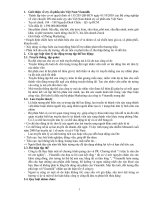- Trang chủ >>
- Đại cương >>
- Kinh tế vi mô
tài liệu – page 2 – tâm lý học vb2k04
Bạn đang xem bản rút gọn của tài liệu. Xem và tải ngay bản đầy đủ của tài liệu tại đây (155.22 KB, 10 trang )
<span class='text_page_counter'>(1)</span><div class='page_container' data-page=1>
ETHICAL PRINCIPLES
OF PSYCHOLOGISTS
AND CODE OF
</div>
<span class='text_page_counter'>(2)</span><div class='page_container' data-page=2>
<b>INTRODUCTION AND </b>
<b>APPLICABILITY</b>
provides a common set of principles and
standards upon which psychologists build their
professional and scientific work in many roles:
such as researcher, educator, diagnostician,
therapist, supervisor, consultant, administrator,
social interventionist, and expert witness.
intended to provide specific standards to cover
</div>
<span class='text_page_counter'>(3)</span><div class='page_container' data-page=3>
<b>GENERAL PRINCIPLES</b>
<b>Principle A: Beneficence and Nonmaleficence</b>
Psychologists strive to benefit those with whom they
work and take care to do no harm. In their
professional actions, psychologists seek to safeguard
the welfare and rights of those with whom they
interact professionally.
<b>Principle B: Fidelity and Responsibility</b>
Psychologists establish relationships of trust with
</div>
<span class='text_page_counter'>(4)</span><div class='page_container' data-page=4>
<b>GENERAL PRINCIPLES</b>
<b>Principle C: Integrity</b>
Psychologists seek to promote accuracy, honesty, and
truthfulness in the science, teaching, and practice of
psychology. In these activities psychologists do not
steal, cheat or engage in fraud, subterfuge, or
intentional misrepresentation of fact.
<b>Principle D: Justice</b>
Psychologists recognize that fairness and justice
entitle all persons to access to and benefit from the
contributions of psychology and to equal quality in
the processes, procedures, and services being
</div>
<span class='text_page_counter'>(5)</span><div class='page_container' data-page=5>
<b>GENERAL PRINCIPLES</b>
<b>Principle E: Respect for People's Rights and Dignity</b>
Psychologists respect the dignity and worth of all people,
and the rights of individuals to privacy, confidentiality,
and self-determination. Psychologists are aware of and
respect cultural, individual, and role differences,
including those based on age, gender, gender identity,
race, ethnicity, culture, national origin, religion, sexual
orientation, disability, language, and socioeconomic
</div>
<span class='text_page_counter'>(6)</span><div class='page_container' data-page=6>
<b>SECTION 1: RESOLVING ETHICAL </b>
<b>ISSUES</b>
<b>Misuse of Psychologists' Work </b>
<b>Conflicts Between Ethics and Law, Regulations, </b>
<b>or Other Governing Legal Authority</b>
<b>Conflicts Between Ethics and Organizational </b>
<b>Demands</b>
<b>Informal Resolution of Ethical Violations </b>
<b>Reporting Ethical Violations</b>
<b>Cooperating with Ethics Committees</b>
<b>Improper Complaints</b>
<b>Unfair Discrimination Against Complainants and </b>
</div>
<span class='text_page_counter'>(7)</span><div class='page_container' data-page=7>
<b>SECTION 2: COMPETENCE</b>
<b>Boundaries of Competence </b>
<b>Providing Services in Emergencies</b>
<b>Maintaining Competence</b>
<b>Bases for Scientific and Professional </b>
<b>Judgments</b>
<b>Delegation of Work to Others</b>
</div>
<span class='text_page_counter'>(8)</span><div class='page_container' data-page=8>
<b>SECTION 3: HUMAN RELATIONS</b>
<b>Unfair Discrimination</b>
<b>Sexual Harassment</b>
<b>Other Harassment</b>
<b>Avoiding Harm</b>
<b>Multiple Relationships </b>
<b>Conflict of Interest</b>
<b>Third-Party Requests for Services</b>
<b>Exploitative Relationships</b>
<b>Cooperation with Other Professionals</b>
<b>Informed Consent</b>
<b>Psychological Services Delivered to or Through Organizations</b>
<b>Interruption of Psychological Services</b>
</div>
<span class='text_page_counter'>(9)</span><div class='page_container' data-page=9>
<b>SECTION 4: PRIVACY AND </b>
<b>CONFIDENTIALITY</b>
<b>Maintaining Confidentiality</b>
<b>Discussing the Limits of Confidentiality</b>
<b>Recording</b>
<b>Minimizing Intrusions on Privacy</b>
<b>Disclosures</b>
<b>Consultations</b>
<b>Use of Confidential Information for Didactic or </b>
</div>
<span class='text_page_counter'>(10)</span><div class='page_container' data-page=10>
<b>OTHER SECTIONS</b>
<b>Section 5: Advertising and Other Public </b>
<b>Statements</b>
<b>Section 6: Record Keeping and Fees</b>
<b>Section 7: Education and Training</b>
<b>Section 8: Research and Publication</b>
<b>Section 9: Assessment</b>
<b>Section 10: Therapy</b>
You will see more on this website:
</div>
<!--links-->









